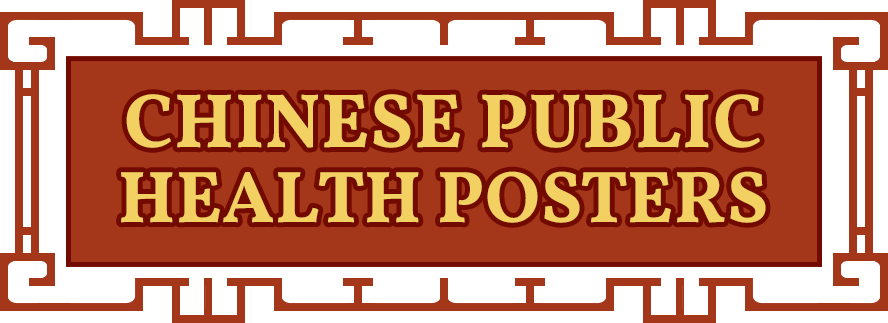Disseminating Health Knowledge: Public Health Campaigns in 20th-Century China
Lesson 4: Health Campaigns of the Masses, 1950s–1970s
The theme of integrating public health into national modernity characterized China’s health campaigns throughout the 20th century. In the 1950s–1970s, mass movements called the patriotic health campaigns were carried out in urban cities and rural villages across China to get rid of the diseases that plagued people. They targeted major epidemics such as cholera, diarrhea, hookworm, typhoid fever, typhus, meningitis, malaria, diphtheria, smallpox, tuberculosis, schistosomiasis, and other diseases. Health posters became an important means to disseminate health knowledge to the masses when China had about an 80% illiteracy rate in the rural villages in the 1950s. Posters were visually powerful, effective, and fast in conveying health information and vivid in teaching new things. They were designed in a direct and self-explanatory manner.
Images:
- 高举毛泽东思想伟大红旗积极行动起来预防呼吸道传染病 (Take actions to prevent respiratory disease), Revolutionary Committee of Jinan Sanitation and Anti-epidemic Station, 1970
- 坚决与危害川南人民的传染病作斗争 (Firmly Fight the Infectious Diseases That Harm the People in Southern Sichuan), Health Bureau of the People's Administration of Southern Sichuan. Printed by the United Printing Society of Luzhou, ca. 1950
Primary Sources
- Bu, Liping and Elizabeth Fee. "Communicating with Pictures: The Vision of Chinese Anti-Malaria Posters." American Journal of Public Health 100.3 (2010): 424-425
- Li, Yushang. "The Elimination of Schistosomiasis in Jiaxing and Haining Counties, 1948-58: Public Health as Political Movement." In Health and Hygiene in Chinese East Asia: Policies and Publics in the Long Twentieth Century. Edited by Angela Ki Che Leung and Charlotte Furth. Durham: Duke University Press, 2010, pp. 204-227.
- Yang, Nianqun. “Disease Prevention, Social Mobilization and Spatial Politics: The Anti Germ-Warfare Incident of 1952 and the 'Patriotic Health Campaign.'" The Chinese Historical Review 11, 2 (2004): 155- 182.
- Zhang, Daqing and Paul U. Unschuld. "China's Barefoot Doctor: Past, Present, and Future," Lancet 372. 9653 (2008): 1865-1867. Available online at .
Secondary Readings
- Chen, C. C. Medicine in Rural China: A Personal Account. Berkeley: University of California Press, 1989, pp. 119-141.
- Lisowski, F. P. "The Emergence and Development of the Barefoot Doctor in China." Eastern Horizon 19 (1980): 6-20.
- Wegman, Myron E., Tsung-Yi Lin and Elizabeth F. Purcell, eds. Public Health in the People's Republic of China. New York: The Josiah Macy, Jr. Foundation, 1973, pp. 109-232.
Online Visual Material for Class Use
- Chinese Poster Foundation. "Barefoot doctors." https://chineseposters.net/themes/barefoot-doctors
- National Library of Medicine. "Community Health: Serving the Community" in Against the Odds: Making a Difference in Global Health. https://www.nlm.nih.gov/exhibition/againsttheodds/exhibit/community_health/serving_community.html
- National Library of Medicine. “面向农村为五亿农民服务 (Go to the countryside to serve the 500 million peasants), 1965” in Chinese Public Health Posters. https://www.nlm.nih.gov/hmd/topics/chinese-posters/poster-politics_101560708-sm.html?imgid=5
- --------. XXXX. “Communicable Disease” in Chinese Public Health Posters. https://www.nlm.nih.gov/hmd/topics/chinese-posters/gallery.html#case0
- --------. XXXX. “Vector-borne Disease” in Chinese Public Health Posters. https://www.nlm.nih.gov/hmd/topics/chinese-posters/gallery.html#case1
- --------. XXXX. “Hygiene and Sanitation” in Chinese Public Health Posters. https://www.nlm.nih.gov/hmd/topics/chinese-posters/gallery.html#case2
Discussion Questions
- What were the major diseases that the mass campaigns tried to get rid of? Why did the campaigns focus on these diseases?.
- How did the poster images teach people to tackle the diseases? Can you tell if any posters specifically targeted the rural population?
- How was the importance of good health related to national development during these decades? Point out some political and economic implications of the health campaigns.
- What techniques did the posters use to make them effective and attractive in conveying health information?
- Why were many barefoot doctors in the posters female?

